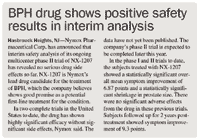Article
PSA can measure prostate size in 'true' BPH patients
San Antonio--PSA can be used to measure prostate size in patients with true BPH, according to a study using information from the Medical Therapy of Prostatic Symptoms (MTOPS) study. Claus G. Roehrborn, MD, and colleagues determined that in men with lower urinary tract symptoms and BPH, more than half of the PSA variability is due to prostate volume.

"In the MTOPS study, I had a unique opportunity to look in a little more detail at [the correlation between total PSA and prostate volume] because in MTOPS, a third of the patients actually got a biopsy at baseline," said Dr. Roehrborn, professor and chairman of the department of urology at The University of Texas Southwestern Medical Center, Dallas. "I could eliminate people who did have cancer or were bound to have cancer... and then I could focus on those patients who actually did have hyperplasia, either fibromyoadenomatous, myomatous, or leiomyomatous hyperplasia."
The researchers looked at MTOPS patients who were older than 50 years, had moderate symptoms (IPSS >8), and a serum PSA of less than 10.0 ng/mL, with no re-strictions on baseline prostate volume. Of the 2,835 randomly chosen men, 1,058 underwent trans-urethral ultrasound-guided biopsies at baseline.

Significant correlations
Spearman correlation coefficients were calculated for the correlation between prostate volume measures and serum PSA for all men and subsets, and data were presented for those men who had a complete set of PSA measurements at baseline. All correlations between total prostate volume, transition zone volume, and total serum PSA were statistically significant (p<.001).
The correlations between transition zone volume and PSA were weaker than those for total prostate volume. In the entire cohort of men, 36% of the variability of serum PSA was explained by prostate
volume. However, in the subgroup of patients with true glandular hyperplasia demonstrated by biopsy, 58% of the variability of serum PSA was explained by prostate volume.
"In this pure BPH hyperplasia population, PSA performs superior in predicting the size. For example, the area near the curve is 0.84, to predict prostate size over 30, 40, 50 grams," Dr. Roehrborn said.
"People have said, clinically PSA and volume may relate, but there's too much random noise there. I took this opportunity of having this biopsy subset to say, yes, there's noise," he explained.
The findings of this study show that PSA has a value for BPH patients even when prostate cancer has been ruled out, Dr. Roehrborn said. Monitoring PSA can measure risk of progression of BPH, symptom worsening, and the need for surgery.
Newsletter
Stay current with the latest urology news and practice-changing insights — sign up now for the essential updates every urologist needs.















